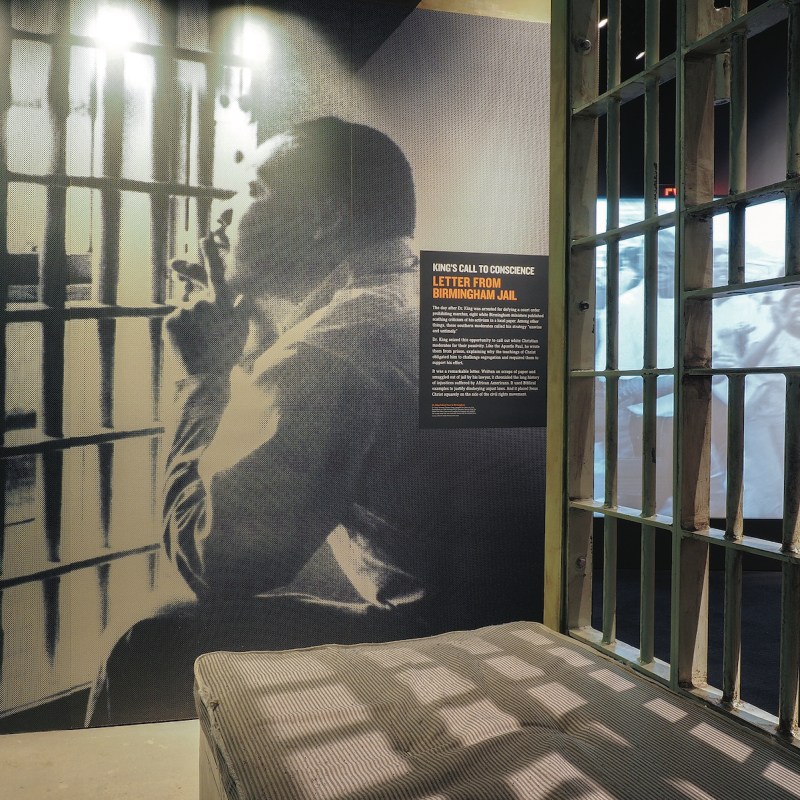
There’s a heap of history in the Lorraine Motel in Memphis. It was a hotel listed in The Negro Motorist Green Book during segregation. It was a safe haven for Black travelers. Back in the day, you could find the likes of Ray Charles, Aretha Franklin, Nat King Cole, Sarah Vaughan, baseball’s Satchel Page and Jackie Robinson, and members of the Harlem Globetrotters staying there.
Videos by TravelAwaits
But what it will forever be remembered for is the day the Rev. Dr. Martin Luther King, Jr. had a date with destiny: April 4, 1968. He was assassinated on the balcony outside his second-floor room. A large white wreath still hangs at the spot. His room, 306, was never rented again and is frozen in time. Today, the room is like it was more than 50 years ago.

By the 1980s, though, the hotel was dilapidated. It was rescued from foreclosure by D’Army Bailey, an activist, lawyer, and judge. He raised more than $140,000 to purchase the motel. He wanted history preserved and for it to serve not only educational purposes but as a rallying call to action. That mission was accomplished. In 1991, the National Civil Rights Museum was created in the former Lorraine Motel.
The museum, which underwent a $27.5 million renovation in the mid-2010s, captures 400 years of Black history through interactive exhibits, collections, films, oral histories, artifacts, educational programs, special events, and more. It is among the top 5 percent of institutions accredited by the American Alliance of Museums and a founding member of the International Coalition of Sites of Conscience, which brings together historic sites, museums, and memory initiatives from around the world, highlighting past struggles and their relevance to the current fight for human rights and social justice.
The National Civil Rights Museum is a must-see if you’re in Memphis and maybe one of the primary reasons you make the trek to town. It’s special. Here’s a little something-something to pique your interest.

1. Room 306
You’ll never forget looking into room 306, where the Rev. Dr. Martin Luther King, Jr. laid his head. The room is as it was. It’s like opening a time capsule with the rotary telephone, ’50s style lamps, small television with antenna, old-fashioned salt and pepper shakers, and what looks like those old-school big local telephone directories. There is a food tray on a table. You’ll likely linger. Feel the ghost. This one grips you.

2. The Year They Walked
There’s something about seeing that life-size bus with the statue of Rosa Parks seated there defiant, closer to the front of the bus than the back where she was “supposed to be” given segregation. When you step on the bus, you’ll get the low down from the audio playing, though the story is familiar — one most everyone hears at some point as a student during their K-12 years. You’ll hear MLK’s speech that he gave on the first night of the boycott. It marks the milestone that the Montgomery Bus Boycott was in the Civil Rights Movement. That so many people walked instead of riding the bus from 1955 to 1956 was a display of sacrifice and selflessness that is hard to imagine in today’s me-me-me world.

3. We Are Prepared to Die
To protest segregated bus terminals, both Black and white civil rights activists challenged the status quo by taking bus trips all around the South in 1961. Black people bravely attempted to use “whites-only” restrooms, waiting rooms, and lunch counters in bus stations in places like Alabama, South Carolina, and elsewhere down South. That defiance led to confrontations and arrests from police, jail time, and unspeakable violence from white protestors. The Freedom Rides were organized by the Congress of Racial Equality (CORE). The rides were sparked by a 1960 Supreme Court decision, Boynton v. Virginia, that extended an earlier ban on segregation of interstate transportation facilities, including bus terminals. The Freedom Riders wanted to see if the ban would be enforced or not. The original 13 Freedom Riders that included the late Congressman John Lewis took a Greyhound Bus from Washington, D.C. on May 4, 1961, with hopes of reaching New Orleans on May 17 to celebrate the seventh anniversary of the landmark Supreme Court decision, Brown v. Board of Education, which declared segregation in America’s public schools unconstitutional. The exhibit with a battered Greyhound Bus brings the saga to life.

4. Standing Up By Sitting Down
Four college freshmen from North Carolina Agricultural & Technical College conducted a sit-in at a whites-only lunch counter at F.W. Woolworth Co store in Greensboro in February of 1960. Their actions helped launch the student sit-ins that shook the nation. The exhibit with an original lunch counter, three-dimensional figures at the counter, as well as disapproving white folks looking at them with disdain is quite an image. The film projected behind the protestors, along with multi-touch, multi-user interaction takes you through the tales of boycotts from around the nation.
5. The Legacy Building
By all means, don’t skip the Legacy Building. It’s the boarding house where it is believed that the assassin’s shot came from. The big draw here is the Civil Rights Timeline. The story doesn’t start in the ’40s or ’50s. It starts in 1619, the year when the first enslaved Africans touched American soil, and ends at the assassination of Dr. Martin Luther King, Jr. For those whose brain can’t quiet conspiracy theories, you’ll definitely want to spend ample time on the second floor, delving into information about the investigation of the assassination, the case against James Earl Ray, and all kinds of fodder to keep you awake at night thinking about what happened. The first-floor exhibits highlight the impact on human rights globally and strive to inspire you to do your part in the still very much needed fight for civil rights.

6. Check Out The Latest Exhibits
While there are permanent exhibitions like Standing Up by Sitting Down, when you’re planning your trip, look at current exhibits for new stuff. Take, for example, Outside the Lorraine: A Photographic Journey to a Sacred Place by David Katzenstein. The yearlong exhibit which ends April 4, 2022, is a collection of more than 90 photos of people who visited the museum. One of the goals of the exhibit as outlined on the museum website, is to expand education, “demonstrating that where a person learns impacts how they learn. Seeing oneself in the photographs helps people identify, connect, and remember on a deeper level. No matter how much one already knows about the Movement, each person is enlightened with a fuller, more personal account when they leave.”
Furthermore, as described on the museum’s website, the exhibit strives to help redefine assumptions about history and identity within the legacy of Dr. King and the Movement. “The knowledge guests have before they arrive and how they come out of the experience is subject to change, whether new or different than before.”
Then there’s Voices of The Civil Rights Movement, which has been on loan to the museum since 2016. It combines two video archives into one interactive exhibit available within a walk-up kiosk. The interactive exhibit is a collaborative project from Comcast and the Equal Justice Initiative. This kiosk combines two media projects: His Dream, Our Stories, commemorates the 50th anniversary of the March on Washington, and Moments in Civil Rights History highlights 52 historic episodes that illustrate the significance of America’s civil rights journey to the present day. The video vignettes are hosted by the museum’s founder, D’Army Bailey.
What To Expect At The National Civil Rights Museum
What makes this museum unique from other Black history museums? “It’s the power of place. To date, there’s no African American history museum where arguably one of the greatest civil rights leaders of a generation was slain and the site was transformed from one of tragedy to triumph,” says Connie Dyson, the museum’s marketing communications manager.
Dyson has advice for visitors: “Don’t be surprised at how much of America’s civil rights history you may not know. Be prepared to engage in the stories of the everyday foot soldiers of the Movement and immerse yourself in how courageous they were. Be enveloped in the dearth of information and visually rich galleries that truly transport visitors back in time. It is an emotional encounter that will impact the way we look at our fellow Americans.”
What might you walk away with? Dyson says, “That freedom isn’t free, and the examples of sacrifices are innumerable, considering the many untold stories of this contemporary history. Visitors will realize it was not that long ago that many of these incidents occurred, and the racial strife we experience today is rooted in our past. If we are to come together as a nation, we must not be afraid to confront these issues and work together respectfully and empathetically for reconciliation.”
Lastly, she adds, “This is an unforgettable, eye-opening experience. No matter where you are in this American story, there’s something here that will resonate with you.”

